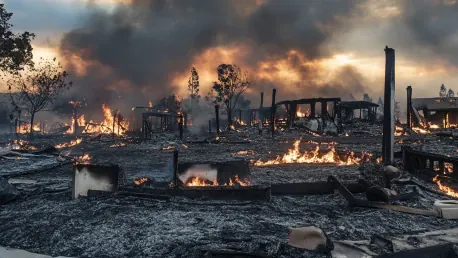California is facing an unprecedented challenge as increasing wildfire risks, driven by climate change, strain the state’s insurance systems. Private insurers are retreating from high-risk areas, leaving homeowners to rely on state-backed “last resort” insurance plans like California’s FAIR Plan. This shift is creating financial instability and potential economic burdens for policyholders, with broader implications for state and national policy.
Wildfire Risks and Insurance Industry Dynamics
In recent years, California has experienced a surge in wildfire activity, with devastating consequences for communities and the environment. The increasing frequency and severity of these fires are largely attributed to climate change, which has led to hotter, drier conditions and longer fire seasons. As a result, private insurance companies are reassessing their risk exposure and withdrawing coverage from high-risk areas, particularly in regions like Los Angeles.
This retreat by private insurers has left many homeowners with limited options, forcing them to turn to state-backed insurance plans designed as a last resort. The California FAIR Plan, originally intended to provide coverage for properties deemed uninsurable by the private market, is now seeing a significant increase in new policies. This influx is putting immense pressure on the plan’s resources and raising concerns about its long-term viability.
The retreat of private insurers from wildfire-prone areas highlights a growing crisis in the insurance industry. With the severity and frequency of wildfires escalating each year, insurers are finding it increasingly difficult to manage their risk portfolios. This trend is exacerbating the challenges faced by homeowners who are already dealing with the direct impacts of devastating fires. The shift towards state-backed insurance solutions presents significant challenges, as these systems were not designed to bear the brunt of such high-risk coverage. Consequently, the financial stability of these plans is in jeopardy, and urgent reforms are necessary to address these concerns and ensure the sustainability of insurance coverage for all Californians.
Financial Strain on FAIR Plans
The California FAIR Plan is currently covering billions of dollars in high-risk properties, far exceeding its original mandate. Experts warn that the plan’s reserves may be insufficient to cover the catastrophic losses from recent and future wildfires. This financial strain is compounded by the fact that the FAIR Plan was not designed to handle such a high volume of high-risk policies. If the FAIR Plan’s reserves are depleted, the financial burden will likely fall on all policyholders in the state. This could result in substantial surcharges, often referred to as a “wildfire tax,” being imposed on homeowners with insurance coverage. Consumer Watchdog, a consumer advocacy group, has projected that these surcharges could amount to nearly $1,000 per Californian, highlighting the potential economic impact on residents.
The increasing financial strain on the FAIR Plan is evident from the growing gap between its available funds and the liabilities it faces. As more properties are covered under the plan, the risk of catastrophic losses also rises, creating an untenable situation. This strain is not just a hypothetical concern; recent fire seasons have already tested the plan’s financial resilience, bringing to light the limitations of its current funding mechanisms. The potential for widespread economic repercussions is significant, with policyholders across the state being affected by possible surcharges. The FAIR Plan’s current liabilities necessitate a reevaluation of its role, funding structure, and the broader approach to managing insurance risks in high-risk areas.
Broader Implications and Nationwide Trends
The challenges faced by California’s insurance market are not unique. Across the United States, state-backed insurance plans are under pressure due to the increasing frequency and severity of natural disasters. States like Florida, which frequently experiences hurricanes, are also grappling with similar issues as their state-backed plans cover large numbers of high-risk properties. This trend creates a cycle where private insurers manage the best risks, leaving state-backed plans to bear the brunt of the worst risks. As a result, the costs associated with these high-risk properties are increasingly being pushed onto taxpayers. This dynamic underscores the need for a more sustainable approach to managing insurance risks in the face of climate change.
The nationwide trend of insurers withdrawing from high-risk markets signals a deeper systemic issue within the insurance industry. As climate change continues to exacerbate natural disasters, the burden on state-backed insurance plans is growing, leading to significant financial exposure. This shift highlights a need for comprehensive strategies that not only ensure the financial stability of these plans but also address the root causes of the increasing risks. The interdependence of private and public insurance mechanisms necessitates a coordinated effort to create a resilient framework capable of handling the changing landscape of natural disaster risks.
Policy and Regulatory Challenges
Insurance companies are advocating for more flexibility in setting rates to better reflect the increasing risks associated with climate change. However, state regulators face the difficult task of balancing consumer protection with the need to maintain a viable insurance market. In California, policy concessions have been made to allow insurers to surcharge policyholders for extreme losses, but these measures have not fully succeeded in keeping insurers in the market.
There is a growing consensus among experts that without addressing the root causes of climate change and limiting development in high-risk areas, the insurance market will become increasingly unsustainable. Some suggest that federal reinsurance programs could provide much-needed support to state-backed plans, offering a financial buffer as private insurers withdraw from high-risk markets. Additionally, creative policy solutions that incentivize risk reduction and promote sustainability could help stabilize the insurance landscape. Effective regulations must strike a delicate balance between allowing insurers to manage their risks and ensuring that coverage remains affordable and accessible for homeowners.
Innovative approaches that integrate climate adaptation strategies into insurance policies are essential to address the escalating challenges. Policymakers are exploring options such as green infrastructure investments, improved building codes, and community-wide risk mitigation projects to reduce the vulnerability of high-risk areas. These measures not only align with broader climate goals but also enhance the resilience of the insurance market. Collaborative efforts between government entities, private insurers, and community stakeholders are critical to developing a cohesive strategy that tackles both immediate and long-term risks associated with natural disasters.
State-Specific Case Studies and Financial Data
California’s FAIR Plan currently holds around $377 million in available claims funds, with an additional $5.75 billion in reinsurance. However, in high-risk areas like Pacific Palisades, where wildfire devastation is particularly severe, the FAIR Plan’s coverage totals nearly $6 billion. This disparity between available funds and potential liabilities highlights the financial vulnerability of the plan. Other states are facing similar challenges. In Florida, for example, state-backed insurance plans are covering a significant number of homes at considerable financial exposure. These case studies illustrate the broader trend of state-backed plans being overwhelmed by the increasing risks associated with natural disasters.
Analyzing case studies from various states offers valuable insights into the common challenges and potential solutions for managing insurance risks. In areas like Malibu and Santa Rosa, the impact of recent wildfires on the insurance market has been profound, with numerous homeowners struggling to find coverage. The financial data from these regions underscore the urgent need for enhanced funding mechanisms, robust risk assessment models, and proactive policy measures. By examining the specific dynamics in different states, stakeholders can identify best practices and tailor strategies that effectively address the unique challenges posed by each region’s risk profile.
Expert Opinions and Future Projections
Insurance experts argue that without significant changes to how risks are managed and shared, the insurance market will continue to face severe challenges. Addressing climate change’s root causes and implementing sustainable development practices are seen as critical steps in mitigating these risks. Some experts suggest that the insurance system may need to be redesigned to function more like a utility, ensuring that it serves the public good and provides extensive risk coverage. There is also a call for federal reinsurance programs to support state-backed plans, providing a necessary financial buffer as private insurers withdraw from high-risk areas. These programs could help stabilize the insurance market and ensure that homeowners have access to affordable coverage.
The future landscape of insurance in the context of growing natural disaster risks requires a transformative approach. Experts emphasize the need for innovative policies that integrate climate resilience into insurance frameworks. Proposals for public-private partnerships, dynamic risk modeling, and community-based risk reduction initiatives are gaining traction as viable solutions. Additionally, the insurance industry must adapt to evolving risk profiles through data-driven strategies that anticipate and mitigate the impacts of climate change. By fostering a collaborative effort among insurers, regulators, policymakers, and communities, a resilient and sustainable insurance market can be achieved, ensuring that homeowners are protected against the increasing threats posed by natural disasters.
Economic Impact and Public Burden
California is grappling with an extraordinary challenge as increasing wildfire risks, driven by climate change, place immense pressure on the state’s insurance industry. The escalating frequency and severity of wildfires have made it financially unsustainable for many private insurers to continue offering coverage in high-risk areas. As a result, these insurers are withdrawing from places most likely to experience devastating fires, leaving many homeowners in a vulnerable position.
Those living in high-risk zones are increasingly dependent on state-sponsored “last resort” insurance plans, such as California’s FAIR Plan. The FAIR Plan, originally designed to provide basic fire insurance for properties that struggle to get coverage through traditional means, is now becoming the primary option for a growing number of homeowners.
This shift has significant financial and economic implications. Policyholders often face higher premiums and reduced coverage, leading to financial strain. Additionally, the increasing reliance on state-backed programs could overwhelm the system, potentially triggering broader economic repercussions.
The effects of this insurance shift extend beyond the individual policyholders. There are broader implications for both state and national policies regarding disaster preparedness, housing market stability, and climate change adaptation. California’s evolving insurance landscape serves as a critical indicator of how environmental challenges can transcend beyond immediate damages, influencing economic stability and policy directions at multiple levels.









